 Rendering via Stillman Development International
Rendering via Stillman Development International
Armen Boyajian, Executive Vice President at Stillman Development International, is incredibly excited about their theater renovation at 215 West 42nd Street. Boyajian discusses how the project will carefully remove, restore and re-incorporate the historic aspects of this old theater and blend it with super-modern, high-tech elements that will make the building not only a standout on 42nd Street but a brand-building opportunity. Together, Stillman and architects Beyer Blinder Belle, which has a wealth of experience in historic restorations with its work on The Frick Collection, The Morgan Library and Museum, and Apollo Theater, are enhancing the elegance of Eugene De Rosa, the original theater architect, into an experiential retail opportunity.
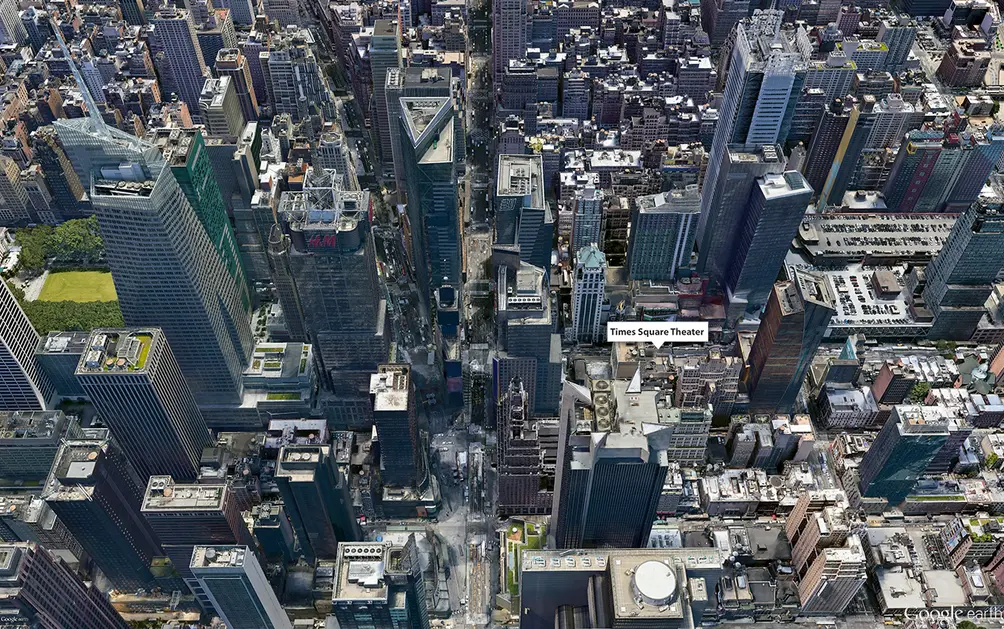 Google Earth aerial of the TImes Square area looking south
Google Earth aerial of the TImes Square area looking south
Armen Boyajian: Before we started designing, we looked at the building in the city and in the world. We have a long-term lease on this vacant theater in Times Square, on 42nd Street between 7th and 8th Avenues. We thought, “It’s been vacant for so long. Wow. What do we do with it?”
What we came up with was to rebuild, reconstruct and restore the building to its former glory. The old theater is a historically significant building both on the interior and exterior. There are historic elements that we were very eager to preserve, restore and treat with a lot of respect throughout our entire plan for our building. We wanted to turn the building into the greatest of all flagship locations. This will be an essential building and location and be a retail branding opportunity for a company to showcase whatever their business is, like Apple, Amazon or Coca-Cola. It is really going to be unique.
What we came up with was to rebuild, reconstruct and restore the building to its former glory. The old theater is a historically significant building both on the interior and exterior. There are historic elements that we were very eager to preserve, restore and treat with a lot of respect throughout our entire plan for our building. We wanted to turn the building into the greatest of all flagship locations. This will be an essential building and location and be a retail branding opportunity for a company to showcase whatever their business is, like Apple, Amazon or Coca-Cola. It is really going to be unique.
"We wanted to turn the building into the greatest of all flagship locations."
The building has 105 feet of street frontage on 42nd Street. In the end, there is a tremendous amount of interior and exterior spaces that we are totally renovating. The building will end up as a very tall four-story building, with one level below grade, and an amazing opportunity with a huge LED signage component on the outside. We are tech-driven so this will be a very cutting edge building juxtaposed on a 100-year-old classically designed building with columns, stucco and elegant interior plasterwork from the theater age.
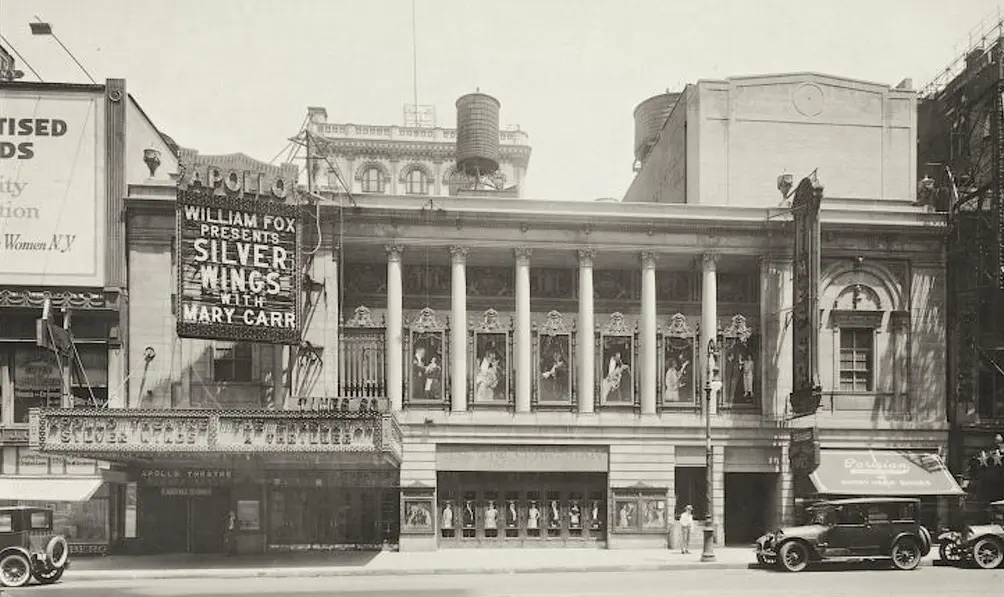 The Times Square Theater in 1922 captured by Wurts Brothers ( New York Public Library's Digital Collection)
The Times Square Theater in 1922 captured by Wurts Brothers ( New York Public Library's Digital Collection)
Can you explain the process?
AB: The exterior and interior of the building are both historic in nature. Normally, we would use word “landmarked” but since this is a theater on 42nd Street, there was a special group created to watch over and protect all 42nd Street theaters in the 1980s and 90s. It is a similar process to landmarking since there is a historic committee and we were obligated to draw up plans, which we are well in the process of, and present it to the committee for approval. The current status is that it is conceptually approved but we are continuing to design and work on the following things:Some of the extraordinary interior features of this building are the plaster proscenium arch that goes around the stage, a big dome ceiling, the sgraffito detailing, the opera seats/box seats and a curved ceiling that ties the top of proscenium arch to the flat ceiling. All those are very large elements. For example, the proscenium arch is 25 feet tall and the dome is about 37 feet in diameter.
We hired a plaster artisan, John Tiedemann, to carefully extract these out of building and crate them to a warehouse where they will be restored off-site. John Tiedemann was founded in 1906 and is now run by Ray Tiedemann, one of John's 54 grandchildren.
Once those features are carefully removed, the next major thing is to brace the facade. The facade is made of limestone, similar to that of the Empire State Building. We will be bracing and ultimately hydraulically lifting the facade five feet up from where it is now, all the way across the building vertically. When we brace it and severe it from the remainder of the building, then we will lift the facade.
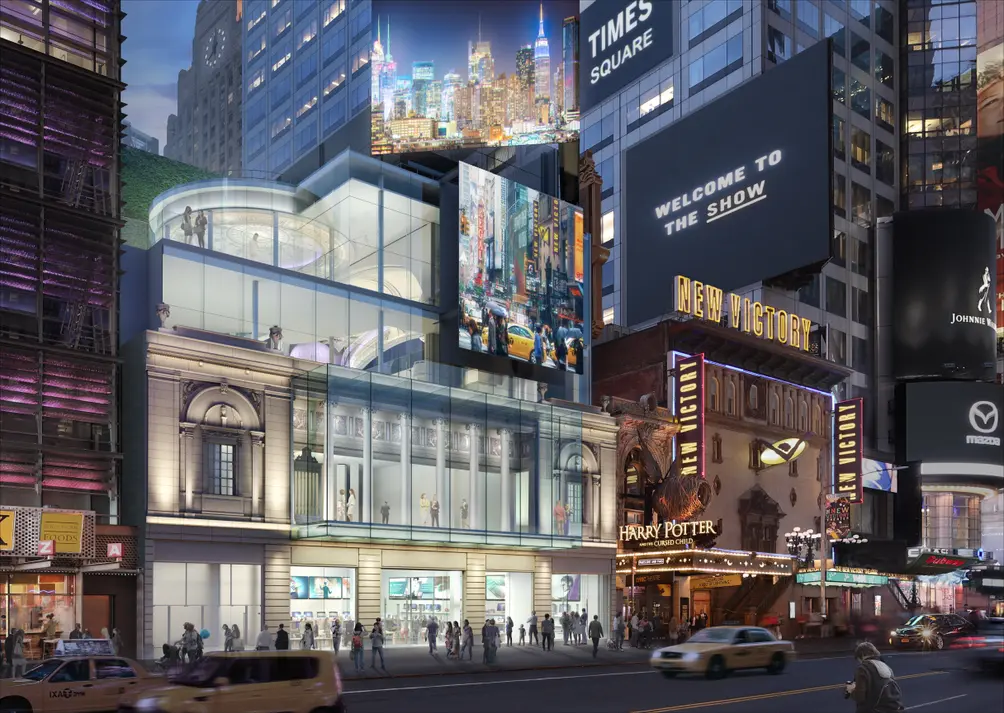 Rendering via Stillman Development International
Rendering via Stillman Development International
The reason we are doing this that is the building is so powerful-looking. It has a wide, columned frontage. There is a lot of base to it and we want to give it more prominence. We also want to create a generous ceiling height on the ground floor. So by lifting the building, we are going to have the ground floor at sidewalk level, and the second floor will align with the bottom of large columns.
After the facade is lifted, we will build the glass box which will project from the exterior. The box will line up with the base of the exterior columns and make those exterior columns interior. You will be able to stand in the box and look all the way up and down 42nd Street.
Once the historic facade is lifted, we will deconstruct the back portion of the building. This is the main historical feature facade. We will deconstruct everything behind it. There is a partial cellar in the building now but we will excavate it further and making it the full area of the lot to make it a usable space one level below grade. Once the foundation is built, we will build a floor below and floors behind that existing historic facade. The building will consist of a cellar, ground floor, second floor, third, and fourth-floor that is setback behind the historic facade.
After the facade is lifted, we will build the glass box which will project from the exterior. The box will line up with the base of the exterior columns and make those exterior columns interior. You will be able to stand in the box and look all the way up and down 42nd Street.
Once the historic facade is lifted, we will deconstruct the back portion of the building. This is the main historical feature facade. We will deconstruct everything behind it. There is a partial cellar in the building now but we will excavate it further and making it the full area of the lot to make it a usable space one level below grade. Once the foundation is built, we will build a floor below and floors behind that existing historic facade. The building will consist of a cellar, ground floor, second floor, third, and fourth-floor that is setback behind the historic facade.
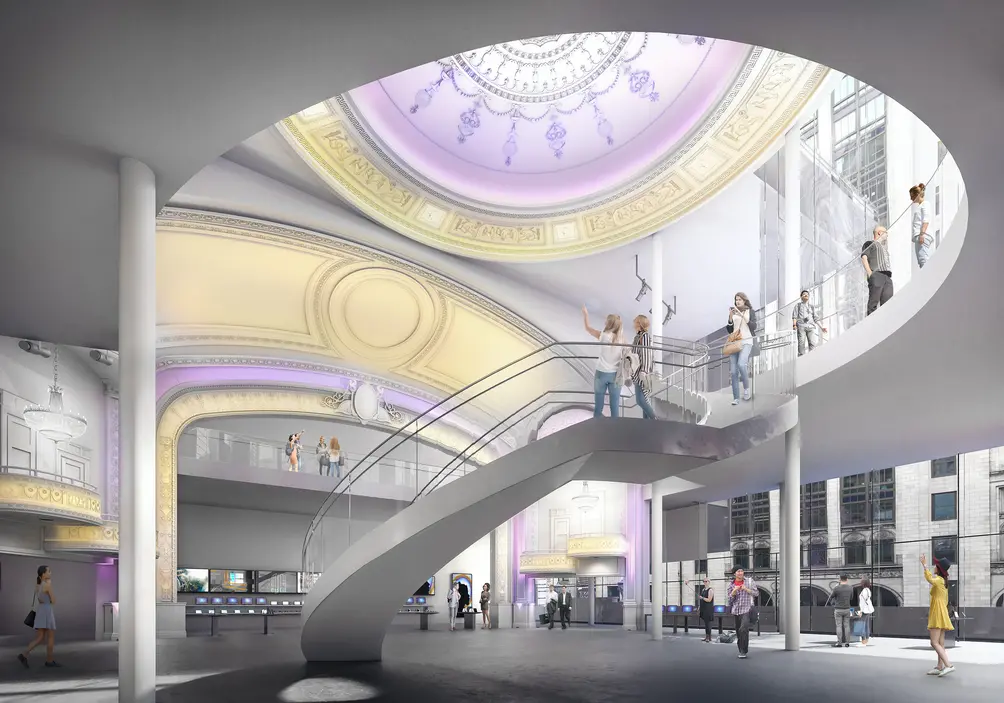 Rendering via Stillman Development International
Rendering via Stillman Development International
"There is a real fantasy to this building that bridges the historic and modern elements."
The third and fourth floors will be finished in glass with a modern look. The third and fourth levels will act together as a double-height space. The interior plaster elements will be restored in pieces and sections once the building is done. We will bring back the historic plaster pieces and install them starting on the third floor with the proscenium arch around the stage. The arch is so tall, it will go up to the fourth floor. Then, the opera boxes will be installed at that level. All of the elements will be tied together by the sail vault.
We wanted to have as many empty spaces as possible so any future tenant can come in and do what they want. The proscenium arch is on the ground floor now and it is the first thing you see. There is a real fantasy to this building that bridges the historic and modern elements.
We wanted to have as many empty spaces as possible so any future tenant can come in and do what they want. The proscenium arch is on the ground floor now and it is the first thing you see. There is a real fantasy to this building that bridges the historic and modern elements.
The glass that envelopes the third and fourth floors creates a real transparency to the building. We felt it was very important for the people on the street to be able to see in and through the building. The glass box is another transparent experience. You will be able to see the columns and behind the columns, the decorative frieze, sgraffito and the beautiful decorative element flat band that runs the width of the opening where the columns are, which we plan to showcase and light up.
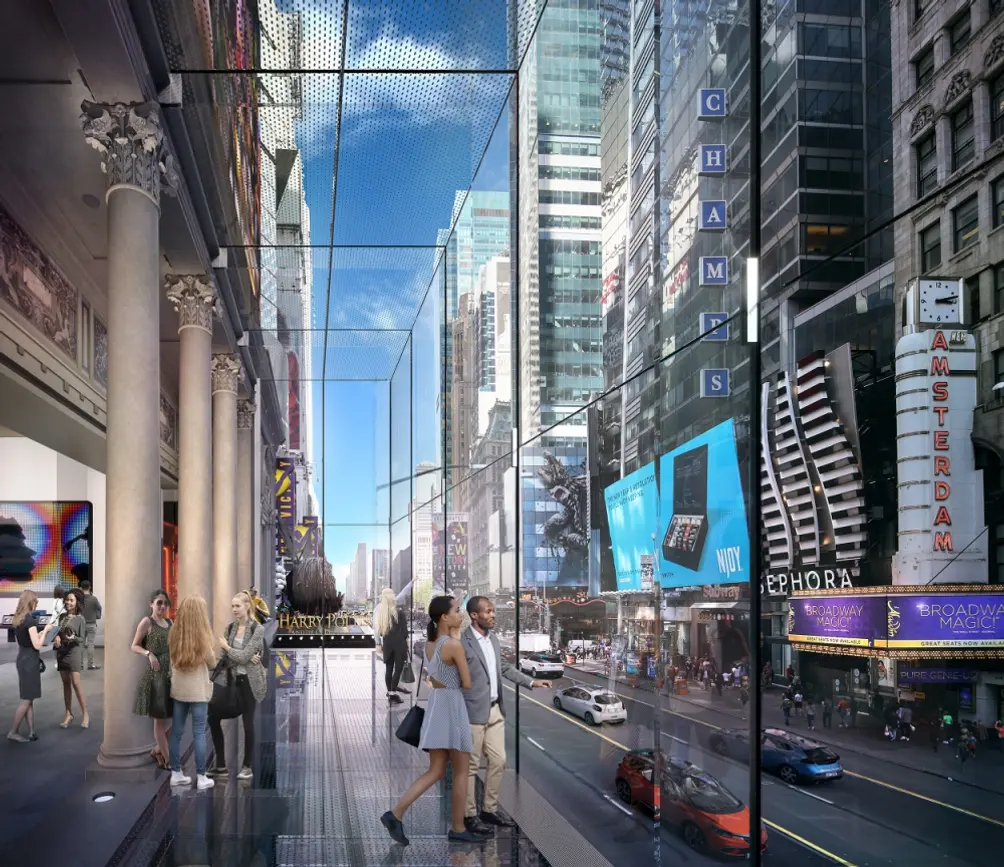 Rendering via Stillman Development International
Rendering via Stillman Development International
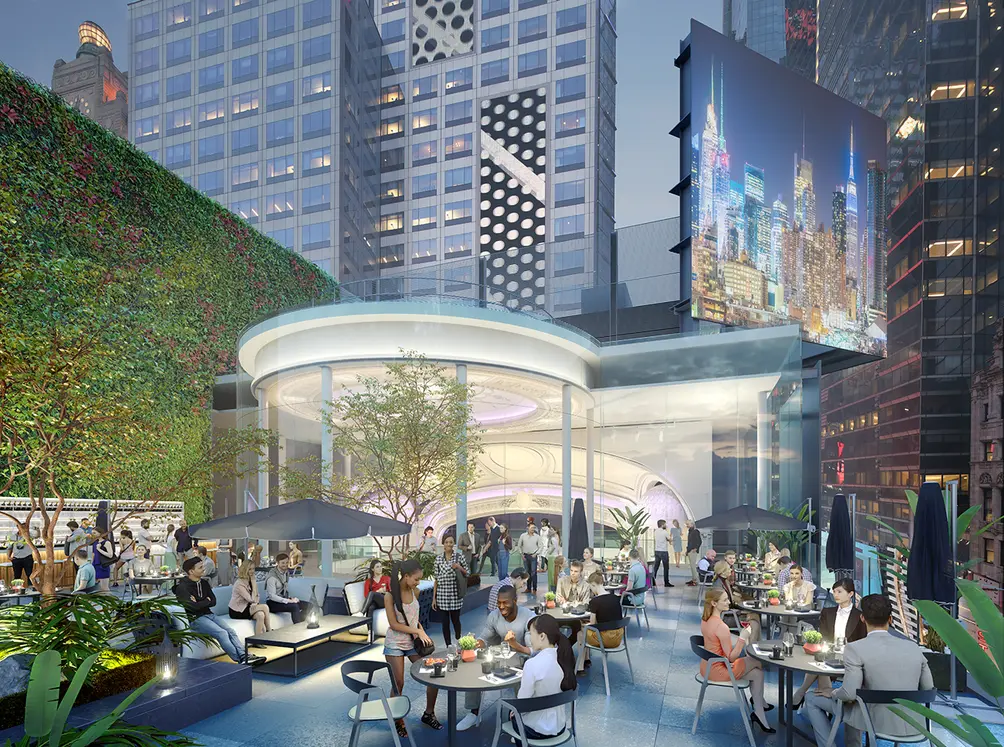 Rendering via Stillman Development International
Rendering via Stillman Development International
Did you ever consider keeping the stage of the theater intact?
AB: When we took over the building, the seats were completely stripped, as was the stage. The building had a brief history as a Broadway theater, but it did not do well financially. So they quickly switched over to vaudeville or burlesque, and then they went on to showing movies. Once they went into showing movies, they put a screen in location of the proscenium arch so that the stage area became a store. We thought about bringing back the stage, but the theater and the size of it was not viable. It would have been a huge challenge to bring the building back in that form. According to the General Project Plan, the city determined the best use of the Times Square Theater is retail space.Brad Mendelson and David Green of Collier’s International NY is handling retail marketing and leasing for the project.
 Ongoing work at the TImes Square Theater as of early March 2020 (CityRealty)
Ongoing work at the TImes Square Theater as of early March 2020 (CityRealty)
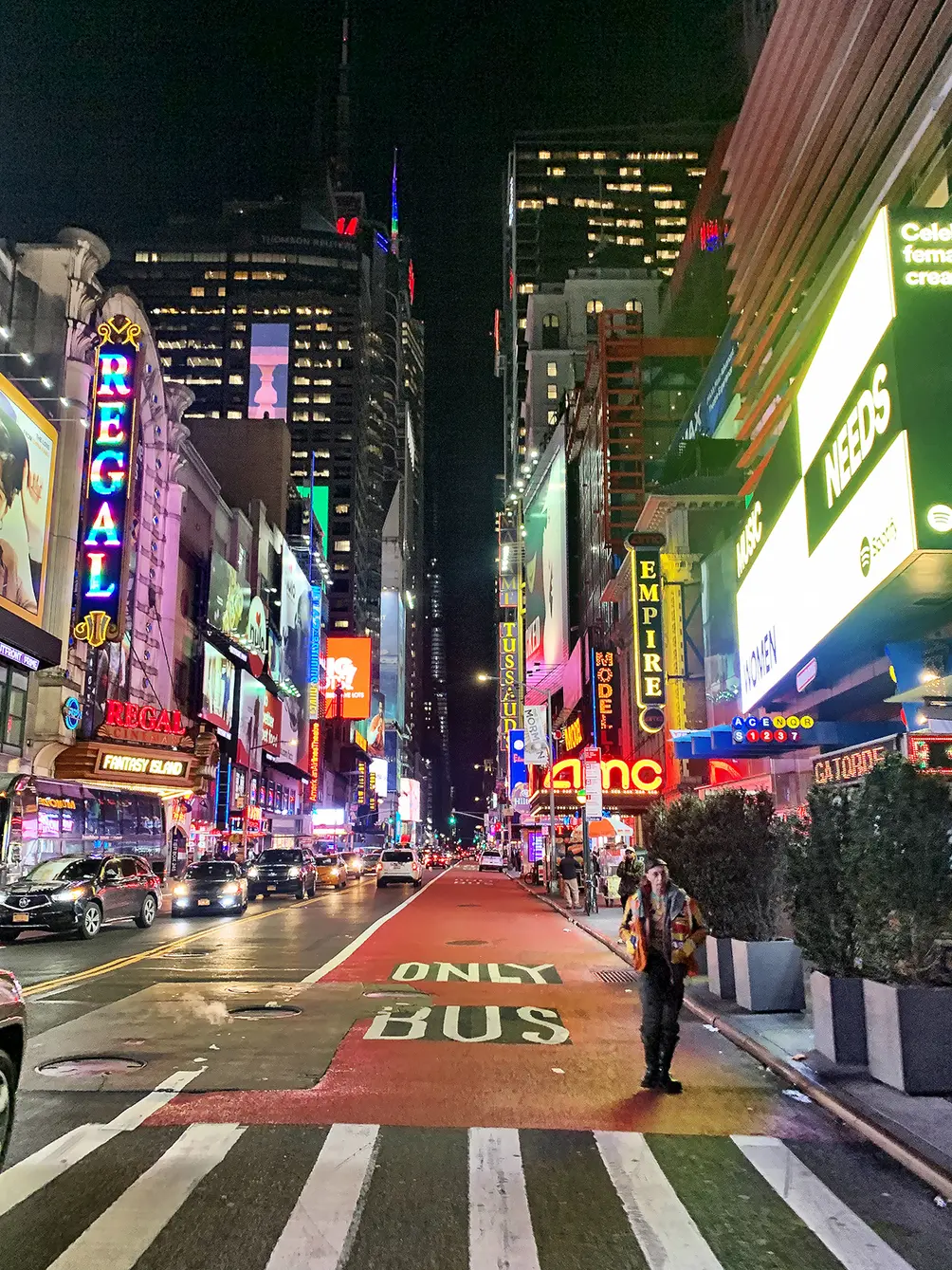 An incredibly subdued 42nd Street thanks to COVID-19
An incredibly subdued 42nd Street thanks to COVID-19
Enjoyed this Article? Like CityRealty on Facebook and follow @CityRealty on Instagram. You can also tweet us at @CityRealtyNY.

Contributing Writer
Michelle Sinclair Colman
Michelle writes children's books and also writes articles about architecture, design and real estate. Those two passions came together in Michelle's first children's book, "Urban Babies Wear Black." Michelle has a Master's degree in Sociology from the University of Minnesota and a Master's degree in the Cities Program from the London School of Economics.

 6sqft delivers the latest on real estate, architecture, and design, straight from New York City.
6sqft delivers the latest on real estate, architecture, and design, straight from New York City.
